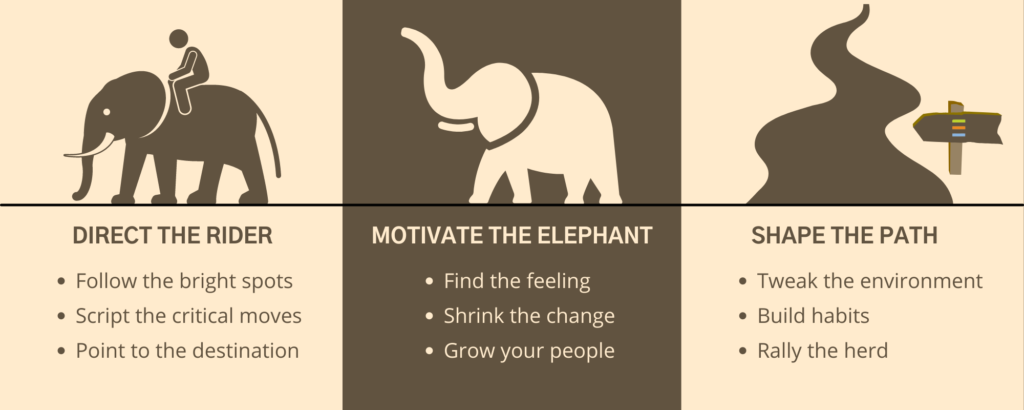SERIES: Thought Leadership Derived From Switch: How to Change Things When Change is Hard – Part 3

In my house, we have three kids and approximately 30 reusable water bottles (a bit much, I agree). I am constantly gathering an inordinate amount of water bottles for cleaning. When the kids can’t find the one they used earlier (they don’t actually look that hard), they just grab another one. To be honest, I would probably do the same thing. This is because their environment, 30 available water bottles, makes it so much easier to choose not to be less wasteful.
As I was reading Switch: How to Change Things When Change is Hard, a solution to the water bottle problem became very clear – each kid gets only ONE water bottle. The limited resource breeds accountability for keeping up with your own water bottle, responsibility to wash your own water bottle, and hopefully this forced behavior creates some good habits in other household chores. The kids didn’t choose to make more work for me, they just chose the path of least resistance. So, when I needed the behavior to change and no amount of family meetings worked, I changed the environment.
In our third and final article of the series dedicated to Switch, we’ll learn how it is often the situation that makes change hard, not necessarily the people. In our previous articles, Directing the Rider and Motivating the Elephant, we looked at the rational and emotional sides of decision-making. The authors of Switch provide many tools to direct the rational side of our brains and motivate the emotional sides to make change easier. But when the behavior just won’t change, you might have to manipulate the situation to encourage people to make a switch.
Tweak the Environment
As a leader, when you are trying to initiate a change and everyone seems to be resisting, take a look at whether it’s actually easy for people to adopt the new behavior. Say you have a new initiative where your sales team is supposed to call prospective clients. As part of that new initiative, they also have to file a report with a manager before making the call. This report is intended to ensure follow-through on the calls, but what it is actually doing is creating friction that makes it more difficult for your reps to call the prospective clients. If you want them to make the calls, make it easier for them to do so.
“As a leader, when you are trying to initiate a change and everyone seems to be resisting, take a look at whether it’s actually easy for people to adopt the new behavior.”
Build Habits
In Switch, the authors offer helpful tools to spring people into consistently practicing a new behavior. They recommend instituting action triggers – stating in advance exactly when and where they intend to do the action. When the sales team is told that they have to make calls to prospective clients, on top of their already busy workload, they may have trouble finding the time to make the calls. But if you tell them that they need to make one call after they pour their first cup of coffee and another call before they sit down to lunch, they have to think less about when they will fit it in. To make the habit stick, encourage your team keep themselves accountable and consistent by blocking the time on their calendar each week. In a previous article, Motivate the Elephant, we learned how to shrink the change, or create simple tasks that can motivate the person to continue doing something. This is how habits are formed.
Start simple, add on, do it over and over again. There are two requirements to consider as you encourage new habits:
- The habit should advance the mission (calls to prospective customers)
- The habit should be relatively easy to do (tweak the environment and offer action triggers)
Another way to form a habit is the good, old fashioned to-do list. Creating a checklist harkens back to one of our tenants in Directing the Rider – eliminate the ambiguity. If there is a known next step, it leaves little room for complex decision-making.

Rally the Herd
In Motivating the Elephant, we learned that there is great benefit to developing a common group persona. Giving an aspirational identity can motivate people to face challenges without defeat and embrace small wins on the way to the end goal. Similarly, as you shape the path to better facilitate your change, you can change the behavior of individuals by creating an identity for the group.
This tool for encouraging new behavior is one we’ve all experienced. Have you ever witnessed an accident and looked around to see if anyone else is running to help? It is human nature to determine first what the group is doing, second what your reaction should be. In organizational change management, we identify and engage an influencer to rally the herd. The influencer is the one that everyone looks to for the behavior they should adopt. People use “social cues” to determine their next move. If you can manufacture this type of collective action, you can get a larger group to adopt a new behavior.
Using the methods offered in Switch – Direct the Rider, Motivate the Elephant, and Shape the Path – leaders can make change easier. The authors of Switch never claim to solve all the problems using these tools and they openly acknowledge that there is no silver bullet to making organizational change stick. The purpose of Switch is to encourage the organization to swim in the same direction rather than battle through turbulent chaos.
In Summary
We first learned about the Rider and his steadfast approach to change in part one of this series. The Rider will forge forward at top speed if he has clear instruction and a clear end goal. But the rational Rider tires out while trying to force an emotional Elephant with logic and strategy. In the second article of this series, we learned how to motivate the large and emotional Elephant. Making the change seem smaller and manageable, and appealing to the feeling side of change, can motivate the Elephant to move in the same direction as the rational Rider. The journey of the Rider and the Elephant becomes far less complicated when the path to making a change is more accommodating. Shaping the path is an approach that can be used in conjunction with the first two tools, or as a solitary alternative. As a leader, we often focus on the people that make change harder or the behaviors that we have to switch, but it is important to understand, as the authors of Switch suggest, that the situation could be the culprit for resistance in your organization.
Is your organization confronting a critical change? Let the experienced change management experts at Fahrenheit Advisors help you navigate it with confidence. Contact us at Experts@FahrenheitAdvisors.com.
About the Author
 Megan Price provides a broad range of experience in strategy development, project management, organizational behavior, corporate culture, stakeholder relations, process integration, and change management. She encourages a collaborative process and tailors work to her individual clients, serving them by drawing on her multi-dimensional industry experience, which includes agriculture, legal services, state and federal government, infrastructure development, and electric utilities.
Megan Price provides a broad range of experience in strategy development, project management, organizational behavior, corporate culture, stakeholder relations, process integration, and change management. She encourages a collaborative process and tailors work to her individual clients, serving them by drawing on her multi-dimensional industry experience, which includes agriculture, legal services, state and federal government, infrastructure development, and electric utilities.
